The serious play of Jacqueline Poncelet in her MIMA
retrospective
In a retrospective looking at five decades of making across
diverse mediums, Jacqueling Poncelet: In The Making is a playful & engaging
explosion of colour, pattern & form. Will Jennings visited & met the
artist, finding that beneath the play there are rich recollections &
serious ideas.
The exhibition begins with a small vitrine. It would be
forgivable for a visitor to even miss such a little cabinet containing eight
delicate, unglazed white bone china vessels. Sitting on a white base, they
could easily be glanced over as eyes are attracted to larger and
more colourful works nearby and calling from the next room. But the
visitor would do well to linger on these pieces made by Jacqueline Poncelet
over four years following her graduation from the Royal College of Art in 1972.
Some are given names suggesting function: Bowl with Hemisphere, Split Level Pot with Double Half Rim, Cast White Bone China Bowl (with Foot). Others are given titles which suggest at a more abstract derivation: Patterned Rimmed Hemisphere, Three Curve Form. Poncelet’s work sits between these two spaces of art and design, and while her work often has an architectural quality about it – and sometimes architectural scale – she is resolutely and explorative artist, unshackled from the restrictions of practicality, building regulations, and a demanding client.
“They have so little control - who'd be an architect?,” the artist says, “You know, one week it's a five storey building, then you go into work the next week and it's six, or the toilets have had to move – I couldn't bare it!” That said, she has deep admiration for architecture, and has worked with it in more profound ways than simply occupying a vitrine in a white-wall gallery such as this Erik van Egeraat-designed space at MIMA in Middlesbrough.
![]()
![]()
In 2012 the artist was commissioned by TfL to create Wrapper, a multicoloured enamel cladding system that wraps service buildings adjacent to Edgeware Road tube station. It is formed of numerous grids, each relating to nearby architectural and urban elements, weaved into a façade designed to stimulate, interest, and possibly confuse from the various angles it can be seen from.
“I really like to think about the place,” the artist explains, adding that “I never know how to say this without it sounding really strange, but to show the place to itself – the Edgware Road work is all about different aspects of Edgeware Road, it doesn't come from some other place, that's important.”
The retrospective exhibition at MIMA – Jacqueline Poncelet: In the Making – however, doesn’t show any images or models of Wrapper. “There are two things I've resisted – a retrospective and a book,” the artist says while standing in the middle of her overdue retrospective, and explains that many of her projects simply weren’t best displayed in the context of a gallery, but her architectural-scale projects will be fully documented in a forthcoming monograph published by Anomie and Hurtwood Publishing. This exhibition, curated by MIMA’s Artistic Director, Elinor Morgan, instead focuses on works that could fit into the gallery in their entirety. Presented in a non-chronological manner, it invites readings between time-periods, mediums, and visual languages – “Because how could you start off making those [bone china pieces] and finish up doing Edgeware Road?” the artist asks in the third person, as if only now able to stand back and observe the intermingling trajectories and ideas that have led to not only the Edgeware Road project, but many works in the decade since.
![]()
![]()
Poncelet was born in Belgium and brought up in the UK, studying Ceramics at the Wolverhampton College of Art, then Industrial Ceramics at the Royal College of Art. “When I was at the Royal College I did make some functional things, but I think it's a bit rude to call them functional,” the artist says, speaking to the space she occupies between art and design. “I made a square plate that had a little gutter around it,” she recalls, “I thought it was such a good design … until the day I served stew on it and the gutter overflowed.”
The exhibition is a journey through artistic mediums, though the ceramics that formed Poncelet’s early education recur throughout. House (2017) incorporates a found roof tile into a small domestic-shaped sculpture with a twisted-rope like section emerging from within, the artist’s recollection of her grandmother’s wringing of the towel used to clean her front steps. Heap (2017) is a gathering of unglazed, red clay which altogether are a frozen representation of the eddies and currents of the River Ogwr close to her studio in Wales.
A series of architectonic stoneware and clay sculptures cover a table, made over the 1980s while Poncelet was a Visiting Artist at Bing & Grøndahl in Copenhagen, one of Denmark’s largest porcelain manufacturers. It was a period she was experimenting not only with form, but colour, these pieces not only showing exploration of interior and exterior spatial play, but also how colour can inform and confuse this relationship. These works all came after a trip to New York in 1978 which the artist states as a seminal moment of transformation for her work, when the business and energy of the place was also observed in its urban fabric. She speaks of “architecture subverted by nature” and “grids with mad patterns in them” which started an approach to making in which pattern could be applied liberally across all mediums.
![]()
![]()
Colour, and its deployment into pattern, are evident more in the next room, with a new floor-to-ceiling wallpaper. It repeats a single digital photograph Poncelet took of an architectural surface in Middlesbrough’s city centre, here abstracting it into a motif beyond representation. Overlapping are 17 panels of older pattern works which similarly play with turning a captured observation into an interlocking pattern – though the smaller versions were all made between 1997 and 2000, built around analogue photographs.
Not all artistic ideas need grand studios and deep pockets. “Snappy Snaps used to do two sets of prints for the price of one,” the artist says of how her initial photo-pattern works began, “and once I discovered that, I couldn't resist it.” Initially getting pairs of images to see which may pattern well, then returning and asking for eight more, then “I’d go back as if eight had been so interesting, I’d want sixteen – and then the point at which sixteen was interesting, then you knew you could do a whole wall.”
Poncelet believes the idea of a work wrapping across a whole wall, creating a pattern-field from mundane photographs of architectural details, is rooted in a lingering memory from a childhood holiday to France: “the French didn't stop the wallpaper at the edge of the wall, it went over the ceiling, it went inside the cupboard – and it was so thrilling.” She then immediately connects this to memories from New York: “the pavements, the patterns, stamped metal ceilings inside shops – and nobody thought to tidy it up.”
![]()
![]()
Over fifty years of making are traversed in the exhibition, including many works Poncelet has not seen or considered for many years, and it is evident that she has had joy in remembering not only the works but also the memories attached to them. Looking at those first bone china works, she says that “I did them so long ago that it's almost like the work isn't yours, you can remember the person, but not quite sure if you can remember them,” then adds that “you're not entirely sure you'd be friends with them!”
One wall work from 1980 was thought to have been lost, only rediscovered in Birmingham City Council’s storage during the planning of this exhibition. A geometric tile system applied to wood, it was formed through raku-firing, an ancient Japanese ceramic process which puts the clay through intense heat, resulting in little control over the final aesthetic finish. It was made after the USA trip, which Poncelet took with her then-husband the artist Richard Deacon, and seeing it again brings back not only artistic but personal recollections: “It's very interesting the way that work gets muddled up with emotions of the time – when we came back from America it was very, very difficult and that work was made at an emotionally very difficult time.” It seems that the raku process undertaken by the material perhaps related to her own personal experiences, yet its rediscovery conjures optimism from the difficult memories: “So it's wonderful to see it and say I was surviving, I didn't feel like it at the time, but I was surviving.”
![]()
![]()
Much of Poncelet’s work is rooted in a sense of being an outsider. As a schoolgirl she had three Japanese pen-friends who would post gifts, opening her eyes to a world colour and unexpected objectness: “The Japanese were a mystery to me, but I loved the products!” As one of only two non-British children at her school, she feels it helped her see the world as an outsider and the beginning of her “attachment to foreignness” which she says has “given me permission to be myself.” To make for the sake of making, not rooting it in an artistic canon or expectation, but seeing everything with liberal openness and possibility.
This sense of discovery and play is perhaps also how a visitor should experience MIMA’s exhibition of Poncelet’s fifty years of making, even if beneath the surfaces, patterns, and colour there are personal and shared meaningful ideas. “You can be serious without having to be serious,” Poncelet says, adding that “the implication is that if it's serious, you shouldn't enjoy it – whereas I want to catch you off guard!”
Some are given names suggesting function: Bowl with Hemisphere, Split Level Pot with Double Half Rim, Cast White Bone China Bowl (with Foot). Others are given titles which suggest at a more abstract derivation: Patterned Rimmed Hemisphere, Three Curve Form. Poncelet’s work sits between these two spaces of art and design, and while her work often has an architectural quality about it – and sometimes architectural scale – she is resolutely and explorative artist, unshackled from the restrictions of practicality, building regulations, and a demanding client.
“They have so little control - who'd be an architect?,” the artist says, “You know, one week it's a five storey building, then you go into work the next week and it's six, or the toilets have had to move – I couldn't bare it!” That said, she has deep admiration for architecture, and has worked with it in more profound ways than simply occupying a vitrine in a white-wall gallery such as this Erik van Egeraat-designed space at MIMA in Middlesbrough.
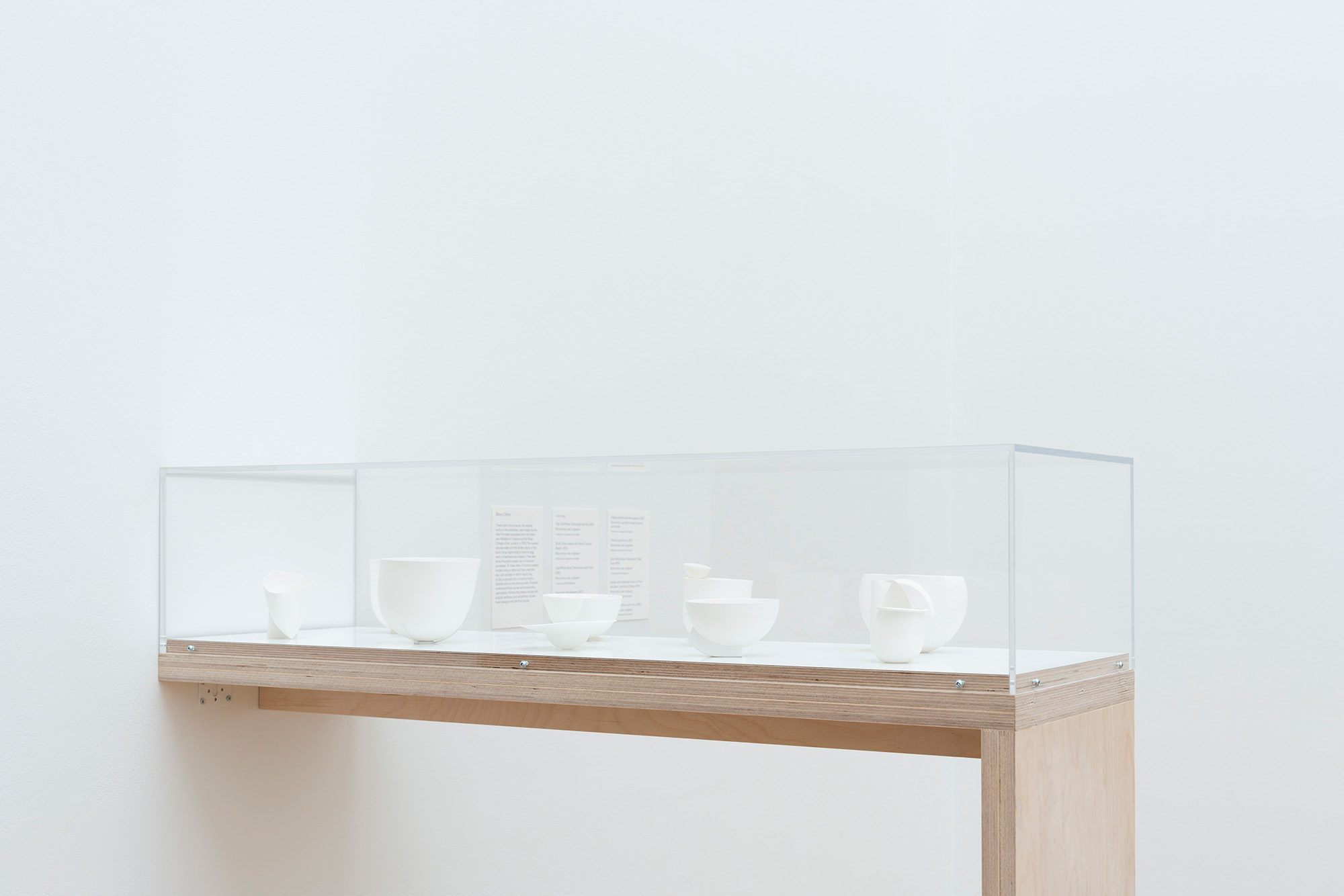

In 2012 the artist was commissioned by TfL to create Wrapper, a multicoloured enamel cladding system that wraps service buildings adjacent to Edgeware Road tube station. It is formed of numerous grids, each relating to nearby architectural and urban elements, weaved into a façade designed to stimulate, interest, and possibly confuse from the various angles it can be seen from.
“I really like to think about the place,” the artist explains, adding that “I never know how to say this without it sounding really strange, but to show the place to itself – the Edgware Road work is all about different aspects of Edgeware Road, it doesn't come from some other place, that's important.”
The retrospective exhibition at MIMA – Jacqueline Poncelet: In the Making – however, doesn’t show any images or models of Wrapper. “There are two things I've resisted – a retrospective and a book,” the artist says while standing in the middle of her overdue retrospective, and explains that many of her projects simply weren’t best displayed in the context of a gallery, but her architectural-scale projects will be fully documented in a forthcoming monograph published by Anomie and Hurtwood Publishing. This exhibition, curated by MIMA’s Artistic Director, Elinor Morgan, instead focuses on works that could fit into the gallery in their entirety. Presented in a non-chronological manner, it invites readings between time-periods, mediums, and visual languages – “Because how could you start off making those [bone china pieces] and finish up doing Edgeware Road?” the artist asks in the third person, as if only now able to stand back and observe the intermingling trajectories and ideas that have led to not only the Edgeware Road project, but many works in the decade since.

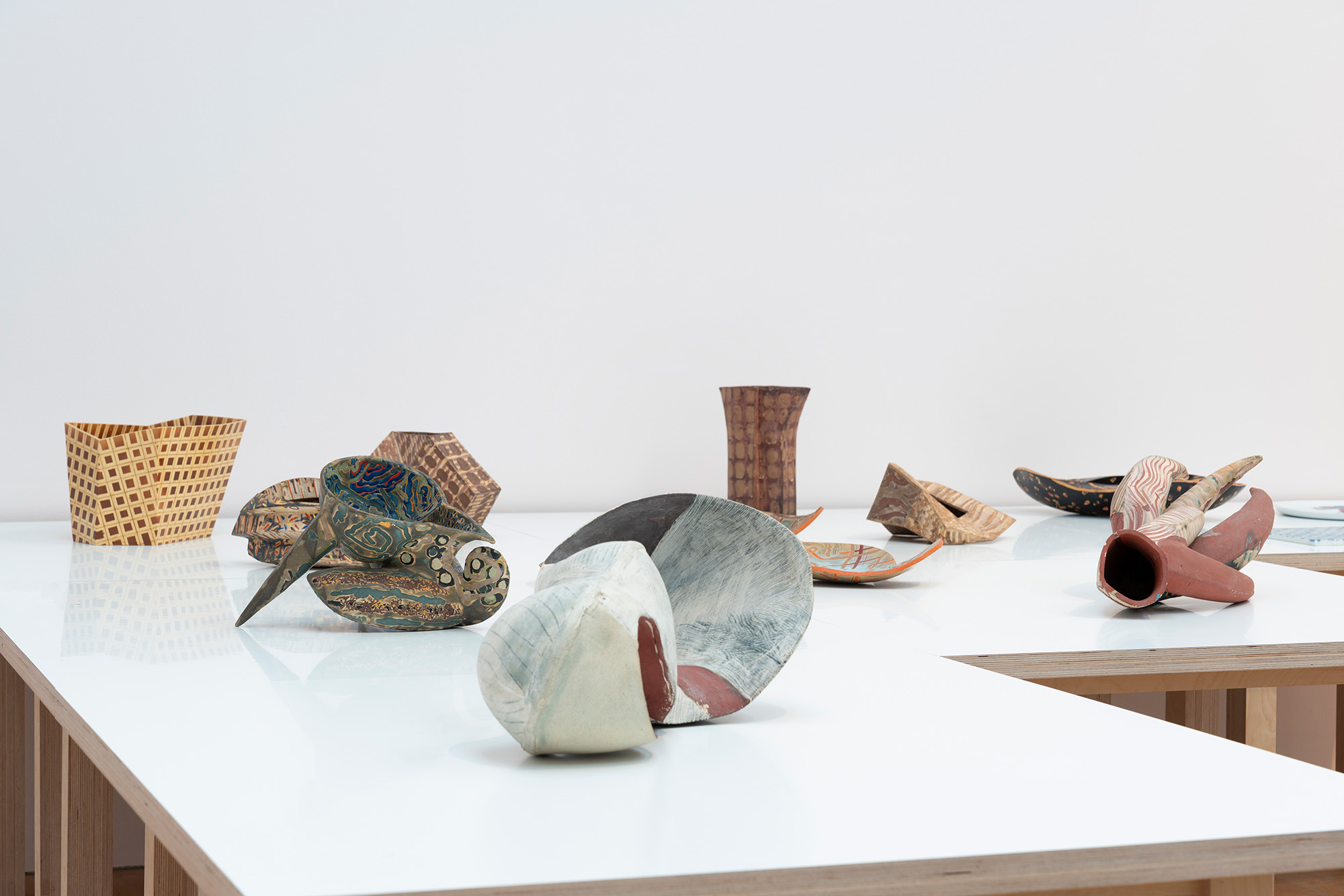
Poncelet was born in Belgium and brought up in the UK, studying Ceramics at the Wolverhampton College of Art, then Industrial Ceramics at the Royal College of Art. “When I was at the Royal College I did make some functional things, but I think it's a bit rude to call them functional,” the artist says, speaking to the space she occupies between art and design. “I made a square plate that had a little gutter around it,” she recalls, “I thought it was such a good design … until the day I served stew on it and the gutter overflowed.”
The exhibition is a journey through artistic mediums, though the ceramics that formed Poncelet’s early education recur throughout. House (2017) incorporates a found roof tile into a small domestic-shaped sculpture with a twisted-rope like section emerging from within, the artist’s recollection of her grandmother’s wringing of the towel used to clean her front steps. Heap (2017) is a gathering of unglazed, red clay which altogether are a frozen representation of the eddies and currents of the River Ogwr close to her studio in Wales.
A series of architectonic stoneware and clay sculptures cover a table, made over the 1980s while Poncelet was a Visiting Artist at Bing & Grøndahl in Copenhagen, one of Denmark’s largest porcelain manufacturers. It was a period she was experimenting not only with form, but colour, these pieces not only showing exploration of interior and exterior spatial play, but also how colour can inform and confuse this relationship. These works all came after a trip to New York in 1978 which the artist states as a seminal moment of transformation for her work, when the business and energy of the place was also observed in its urban fabric. She speaks of “architecture subverted by nature” and “grids with mad patterns in them” which started an approach to making in which pattern could be applied liberally across all mediums.
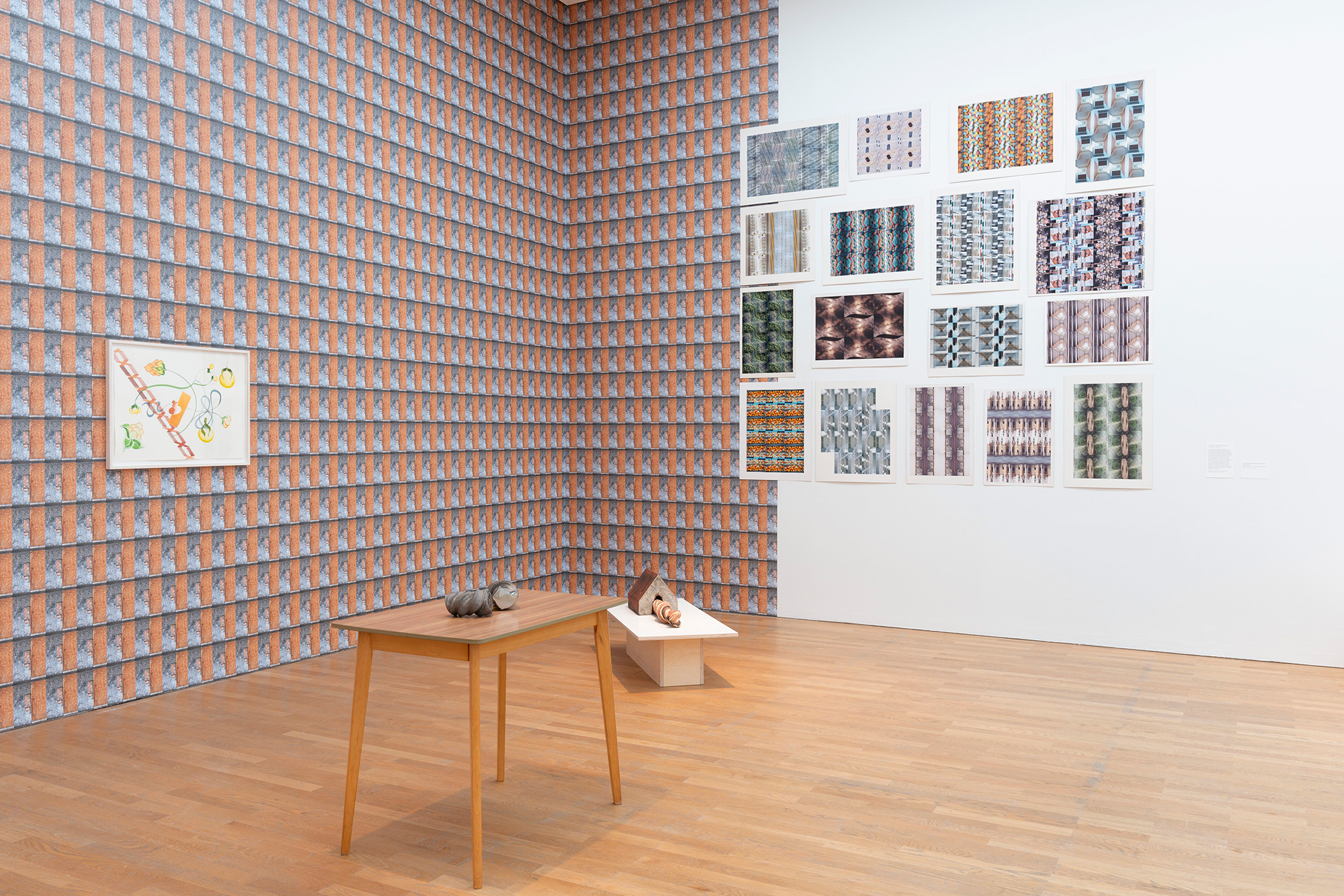
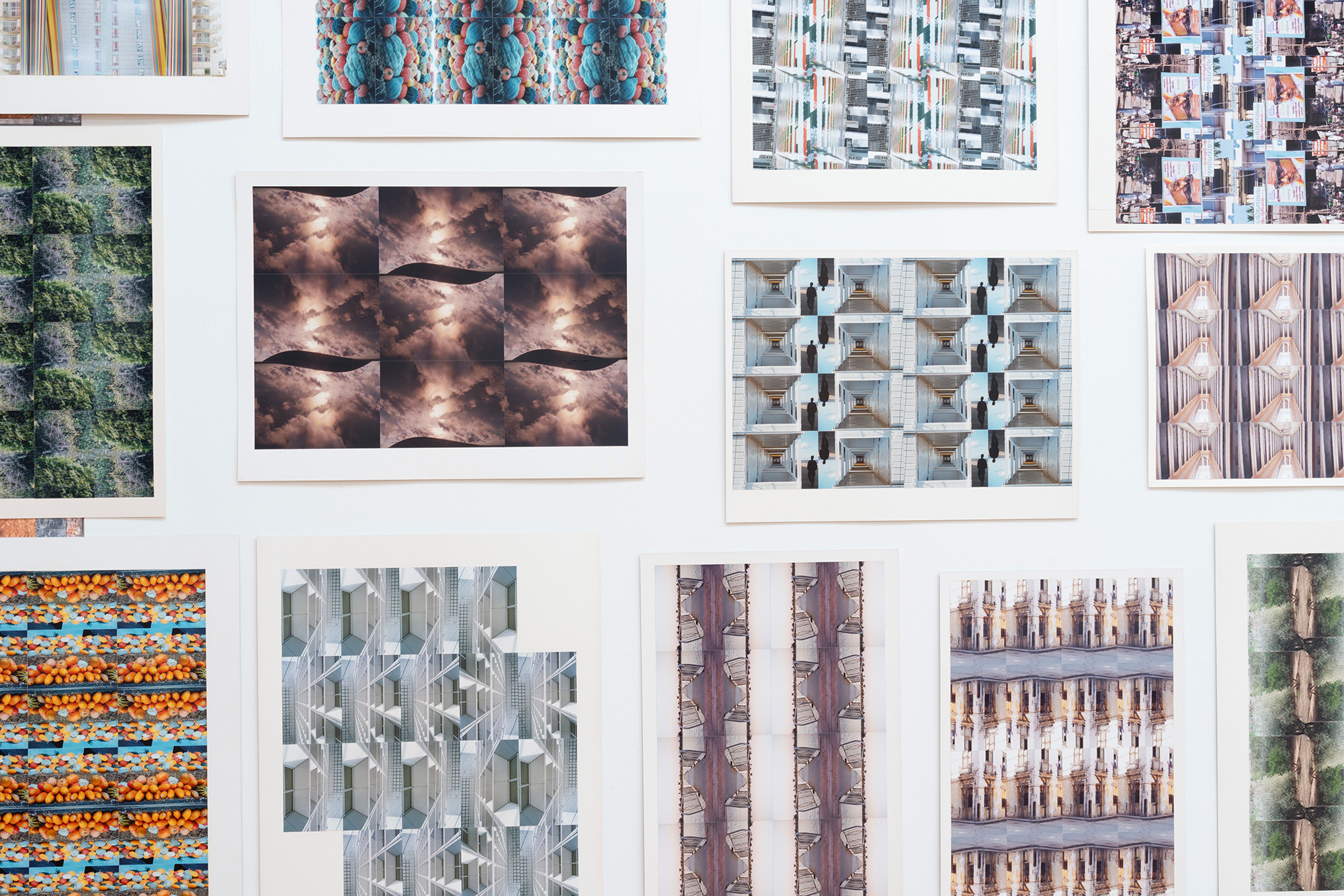
Colour, and its deployment into pattern, are evident more in the next room, with a new floor-to-ceiling wallpaper. It repeats a single digital photograph Poncelet took of an architectural surface in Middlesbrough’s city centre, here abstracting it into a motif beyond representation. Overlapping are 17 panels of older pattern works which similarly play with turning a captured observation into an interlocking pattern – though the smaller versions were all made between 1997 and 2000, built around analogue photographs.
Not all artistic ideas need grand studios and deep pockets. “Snappy Snaps used to do two sets of prints for the price of one,” the artist says of how her initial photo-pattern works began, “and once I discovered that, I couldn't resist it.” Initially getting pairs of images to see which may pattern well, then returning and asking for eight more, then “I’d go back as if eight had been so interesting, I’d want sixteen – and then the point at which sixteen was interesting, then you knew you could do a whole wall.”
Poncelet believes the idea of a work wrapping across a whole wall, creating a pattern-field from mundane photographs of architectural details, is rooted in a lingering memory from a childhood holiday to France: “the French didn't stop the wallpaper at the edge of the wall, it went over the ceiling, it went inside the cupboard – and it was so thrilling.” She then immediately connects this to memories from New York: “the pavements, the patterns, stamped metal ceilings inside shops – and nobody thought to tidy it up.”


Over fifty years of making are traversed in the exhibition, including many works Poncelet has not seen or considered for many years, and it is evident that she has had joy in remembering not only the works but also the memories attached to them. Looking at those first bone china works, she says that “I did them so long ago that it's almost like the work isn't yours, you can remember the person, but not quite sure if you can remember them,” then adds that “you're not entirely sure you'd be friends with them!”
One wall work from 1980 was thought to have been lost, only rediscovered in Birmingham City Council’s storage during the planning of this exhibition. A geometric tile system applied to wood, it was formed through raku-firing, an ancient Japanese ceramic process which puts the clay through intense heat, resulting in little control over the final aesthetic finish. It was made after the USA trip, which Poncelet took with her then-husband the artist Richard Deacon, and seeing it again brings back not only artistic but personal recollections: “It's very interesting the way that work gets muddled up with emotions of the time – when we came back from America it was very, very difficult and that work was made at an emotionally very difficult time.” It seems that the raku process undertaken by the material perhaps related to her own personal experiences, yet its rediscovery conjures optimism from the difficult memories: “So it's wonderful to see it and say I was surviving, I didn't feel like it at the time, but I was surviving.”

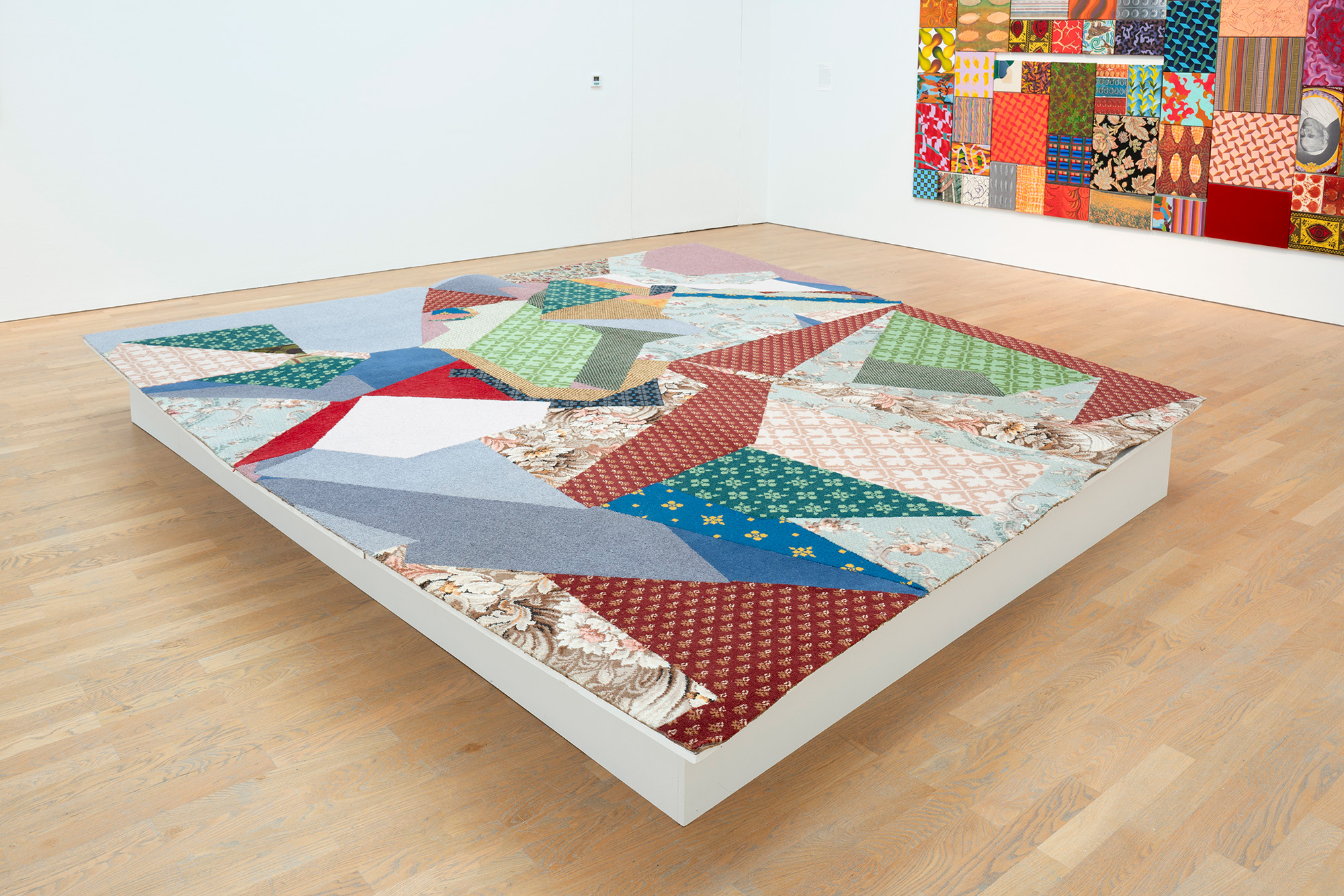
Much of Poncelet’s work is rooted in a sense of being an outsider. As a schoolgirl she had three Japanese pen-friends who would post gifts, opening her eyes to a world colour and unexpected objectness: “The Japanese were a mystery to me, but I loved the products!” As one of only two non-British children at her school, she feels it helped her see the world as an outsider and the beginning of her “attachment to foreignness” which she says has “given me permission to be myself.” To make for the sake of making, not rooting it in an artistic canon or expectation, but seeing everything with liberal openness and possibility.
This sense of discovery and play is perhaps also how a visitor should experience MIMA’s exhibition of Poncelet’s fifty years of making, even if beneath the surfaces, patterns, and colour there are personal and shared meaningful ideas. “You can be serious without having to be serious,” Poncelet says, adding that “the implication is that if it's serious, you shouldn't enjoy it – whereas I want to catch you off guard!”
Jacqueline Poncelet was born in 1947 Liege, Belgium, and grew up in Birmingham, UK. She has lived in London for many years and now spends half her time in rural Wales. She studied Ceramics at Wolverhampton College of Art (1965-1969) and an M.A. Ceramics at Royal College of Art (1969-1972). Jacqueline has works in important national and international collections including Arts Council England, Tate, MOMA, Stedelijk Museum, and MIMA. She has been awarded a British Council Arts Fellowship in the United States, and has exhibited extensively, with exhibitions in Japan, the US, Denmark, Australia, at the Venice Biennial and across the United Kingdom.
www.jacquelineponcelet.co.uk
Will Jennings is a London based writer, visual artist, and educator interested in cities, architecture, and culture. He has written for the RIBA Journal, the Journal of Civic Architecture, Quietus, The Wire, the Guardian, and Icon. He teaches history and theory at UCL Bartlett and Greenwich University, and is director of UK cultural charity Hypha Studios.
www.willjennings.info
www.willjennings.info


